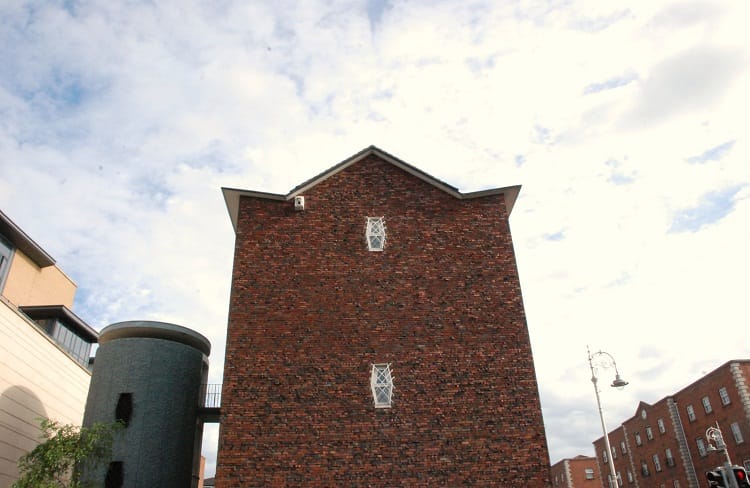What’s the best way to tell area residents about plans for a new asylum shelter nearby?
The government should tell communities directly about plans for new asylum shelters, some activists and politicians say.
Look up on Gardiner Street and you might notice the square white faces, their mouths agape and eyebrows like Denis Healey.

It was a bright April afternoon when Stoneybatter-based photographer Gregory Dunn looked towards the sky on Gardiner Street and paused to take in what he saw.
Bounded by Railway Street and Sean McDermott Street, the flats shone bright in the sun. Their broken brickwork looked similar to some he had seen in Seattle in the United States, a flashback that made him curious.
So did the large, square stone face that he noticed. “It’s certainly a mystery,” he says.
In the playground opposite the complex, Dunn got chatting with three lads “off their faces”. He showed them the photos that he had just taken of the strange feature that stuck out from the roof, mouth agape, eyebrows like Denis Healey.
“‘Yeah’, one of them said,” he recalls. “‘It’s like one of them gargoyles.’”

Some public works of art are large-scale commissions. Some are smaller embellishments with well-catalogued histories. The origins of others are mysterious.
The two faces that look out from the Gardiner Street flats towards Mounjoy Square, and towards the Liffey, have been there for nearly 60 years.
The city architect back then was a man called Daithí Hanly, whose tenure was marked by the proliferation of multi-storey flat complexes like the one on Gardiner Street Lower, which was built from the late 1950s to the 1970s.
At the time, “there emerged a renewed interest in the regenerative role of the new modern flat building”, wrote architectural historian Ellen Rowley in 2011 in the book Dublin Flats by Willem Heeffer.
Between 1959 and 1974, approximately 35 of these “maisonette schemes” were built in Dublin, says Rowley. They stand out for their “butterfly” or “gull-wing” roof shape, and while some of their features are traditional, others are novel.
Like the two solitary gargoyles placed high up on one of the first maisonettes built during Hanley’s time.
The two heads on Gardiner Street weren’t a later addition to the building. They were built at the same time as the corporation flats, appearing in a black-and-white photograph in the Architectural Survey of 1961.
Listed in the _Architectural Survey _are the names of the many now-defunct companies contracted to help build the complex: A. Noyek & Sons, Cunningham Bros Ltd, Clondalkin Concrete Ltd.
That’s all the Irish Architectural Archive on Merrion Square yields on the subject.
But gargoyles do traditionally have a purpose beyond decoration. “We think they’re rainspout gargoyles,” says Dublin City Council Heritage Officer Charles Duggan. “But we do not have any further information on [them].”
The gargoyles are idiosyncratic, unexplained and would appear to be unique to the Gardiner Street gull-wing flats, says Duggan.
It wouldn’t be the first flat complex of Hanly’s to feature unusual artworks. The bright flat mosaics of Kevin Street and North Strand Road also date back to his time.
The Civic Archives on Pearse Street, which hold the files on most council-built structures, only contain records from the late ’70s and ’80s.
There’s plenty on the brickwork. The corporation, as it was known at the time, sent back the bricks originally delivered as they were deemed unsuitable. But there’s no mention of the gargoyles.
On Friday evening, at Lower Gardiner Street, residents arrive home for the evening. Nobody seemed to have any insight into the gargoyles. Few had noticed they were there.
It’s known that Hanly had the dismantled facade of the Abbey Theatre transported to his garden in Dalkey in 1961, according to architect Shane O’Toole.
So could the gargoyles have first featured on the national theatre’s entrance, only then to be tacked upon a corporation flat to serve another purpose? Or were they purpose-built in plaster for Dublin’s latest social housing?
Whatever the story, they are “a wonderfully curious thing”, says Duggan. “And sometimes a bit of mystery surrounding an object such as this only adds to its interest.”
Our Brushing Up series takes a closer look at works of art that you might have noticed around the city, from stained-glass windows to tucked-away statues. Have you spotted one? Let us know at info@dublininquirer.com.
Get our latest headlines in one of them, and recommendations for things to do in Dublin in the other.